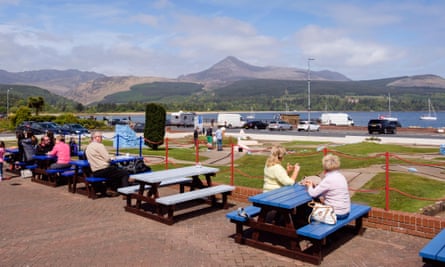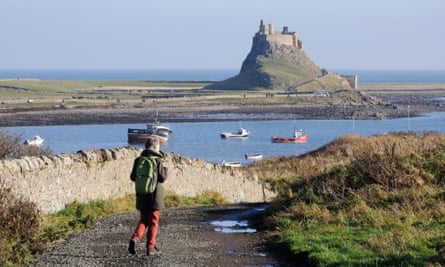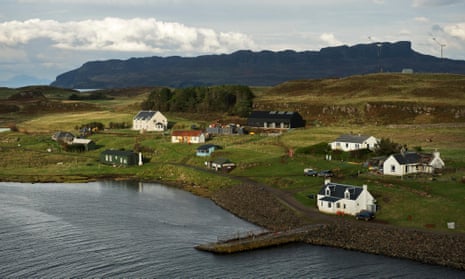In those far-flung outposts of Britain’s influence where diplomats circle the Chesterfields of an evening and gossip over brandy, an old story is never far away. It is the story of a meeting – never recorded – that took place between officials of Britain and Norway to discuss the matter of how one might go about depopulating one’s islands. It is whispered that the government of Norway, restored once more following the Nazi occupation of the second world war, approached the UK seeking advice on a robust strategy towards its islands.
Happily for future generations of Norwegians, their postwar government ignored what Britain told them, which was to evacuate the islands on the grounds of cost and security and gradually cause them to run down. Norway’s island communities thrived and became a powerhouse, while Britain’s suffered from a policy that has since been described as one of “benign neglect”. In Scotland, which has 99 populated islands – two-thirds of the UK’s total – it wasn’t until the creation of the Highlands and Islands Development Board in 1965 that its islands began to thrive once more.
Still, the cost of public services in these areas, per head of population, is higher than anywhere else in the UK.
Islands are an economic and administrative nightmare for those countries who were bequeathed them in the Earth’s infant years. So much toil and trouble for so few people: why can’t folk just be sensible and live on the mainland where they can be reached much more cheaply? Don’t they realise how difficult it is to defend these places?
Earlier this month, the tiny Hebridean island of Muck (population: 30) sent out a global appeal via social media for a primary teacher for its seven children. The school’s popular teacher had quit and none of the initial six candidates followed up on their initial interest, as the reality of life on an island without a shop and cut off from the mainland for several months in the year began to dawn on them.
Yet following the Facebook appeal, Highland Council has been swamped with applications from all over the globe for the £35,000 a year post, which brings with it a three-bedroom flat and, in the opinion of the last teacher, Julie Baker, “a short commute and stunning views over the sea to Ardnamurchan Point”. These places might be remote and require small triumphs of human endurance, but people will always want to live in them.

The hi-tech accoutrements of modern life and the instant gratification that they bestow might once have been considered a threat to an island existence, rendering it all but obsolete; instead it has brought a renaissance in remoteness. The internet and social media have made life on an island that little bit less remote and made the task of running a business on it a lot less costly. In the last census the overwhelming majority of Scotland’s islands saw their populations increase.
Mike Russell, Scotland’s new Brexit minister, is the MSP representing Argyll and Bute in the Scottish parliament. He might also reasonably be called the UK’s minister for islands, as 23 of them lie within the boundaries of his constituency.
“The economy and business of the islands is not just important to the people who live and work there,” he said, “but they are also of crucial importance to the economy of Scotland and the UK. Around two per cent of Scotland’s population lives on our islands and we, as a government, have a moral duty to ensure that they are treated equally and that our public services, which the rest of us take for granted, are accessible to them too.”
Russell is married to an islander and lived in the Western Isles for several years. He is acutely aware of the lazy assumptions and mocking antipathy that sometimes characterises mainland attitudes towards islanders. “In all my years living among islanders and dealing with them I have found them not to be any different than anyone else. The myth of curious and strange island ‘ways’ is just that – a myth. Certainly, you need to be possessed of a degree of endurance to prevail in climatic extremes, but there are great rewards too.”
Mainland UK, it seems, has never been more attuned to the economic importance of the islands. Last week the Scottish government announced that legislation for its long-awaited islands bill would be brought forward within the next 12 months and that a wide-ranging public consultation would help shape it.
Scotland’s island constituency numbers around 250,000 people and they are beginning to make their views known. Like many others during the referendum on Scottish independence, they were engaged and enfranchised by the debate. A common theme running through the hundreds of responses to the legislation was that a “one-size-fits-all” approach to legislation, policy and services does not pay heed to the unique requirements of life on Scotland’s islands.
Residents want government legislation affecting public services to be “island-proof”, meaning that it must exhibit greater understanding of island issues. This, according to the Scottish government, would bring “more sustainability; greater accountability of authorities; empowerment of communities; consistency with European provision; more efficient use of resources; and wider benefits to the Scottish and UK economies”.
On Arran, the seventh-largest Scottish island, there is optimism that some recent depressing trends can be reversed. This gorgeous island is bounded by the Ayrshire coast on one side and the Argyll peninsula on the other. It has been described as “Scotland in miniature” and a one-hour drive over its sinewy roads tells you why. Mountains, lochs, fields and oceans are gathered in and around an island of breathtaking beauty.

Laura Helliwell, born and bred in Arran, had, like many others in her Arran High School class, moved away from the island, but recently returned to manage the Ormidale Hotel, which has been run by three generations of her family since the 1930s. “It wasn’t just the hotel that brought me back, it was the opportunity to bring my children up in this environment. The schools on the island are great and there is a real community spirit conveying values that I want my children to be exposed to.
“Even if they move away from here I want their values to be shaped by having spent their childhoods here. The vast majority of my classmates growing up have all moved from here but, in recent years, some of them have begun to return, probably for the same reasons as I did.”
Like other islands around the UK, Arran has become a haven for retired people. When you add some very tasty house prices on the island into the mix, it doesn’t look like the population will be getting any younger any time soon.
The island’s population stands at around 4,600 and the trend is pointing towards further depopulation as the elderly diminish in number and its young people leave. Yet local businessman Derek Shand, who is also a contractor for Business Gateway Services in Arran and Cumbrae, is optimistic about Arran’s future.
“Last year we had 41 business startups and 39 are still with us and reporting good outlooks. We have 165 employers employing 1,645 employees. Their biggest challenge is sourcing staff and securing affordable accommodation. The island can also employ almost 500 seasonal staff, and recent tourism trends tell us that the season is growing and the shoulder months are reducing.”
In last week’s Arran Banner, the weekly newspaper that has served the island since 1974 and which is bought by more than 90% of the island population, the latest excellent academic achievements of Arran High School are recorded and celebrated and there are signs that, though many will pursue careers on the mainland, some will return with children and try to build a life here.
Shand says: “The current trend shows returning children of islanders buying or leasing their own businesses or taking over from their parents. For the first time in many years we have a very strong young farmers’ club with sons and daughters returning from mainland colleges. There are still 63 registered farms or smallholdings on Arran.”
The introduction of the road equivalent tariff, which caps ferry fares at the same rate as bus travel, has been a boon to the Scottish islands. As the ferry fares have reduced, so the footfall has increased. Some businesses, such as the renowned Arran Aromatics and the Arran Brewery, have seen an increase in customers. An island development officer has been appointed and there is a recognition, at last, that a traditional island community can thrive and be fit to meet the challenges of the 21st century.
Laura Helliwell is pleased with the bookings she has taken for the season so far. “I think people are now beginning to recognise that new technology and the internet have the potential to be good for remote island communities. It has brought our places to the doorsteps of people living continents away.
“They can see us on their laptop screens and then make a booking without worrying about the language barrier. Prestwick airport is nearby, bringing cheap Ryanair flights, so that helps too.”
On a pier surrounded by fields and mountains and where you first encounter Arran, a new ferry terminal is beginning to take shape. Further up the road, land for a new island helipad is being developed. There are four hotels for sale and three restaurants. There are “for sale” signs on handsome dwellings perched on their own little Edens all over the island.
There are opportunities in these places to detach yourself from the world, but to remain in touch all year round.

OFFSHORE HAVENS
Lindisfarne
Population: 180
A tidal island off the north-east coast of England and one of the most famous of the UK’s ancient places of pilgrimage. It was a centre of Celtic Christianity, especially under Saint Aidan and Saint Cuthbert.
St Agnes
Population: 82
St Agnes is the southernmost populated island of the Isles of Scilly, and Troy Town Farm on the island is the southernmost settlement in the UK. It is regarded by many as one of the most beautiful of England’s small islands.
Lewis and Harris
Population: 20,500
The largest island off the coast of the UK and Ireland. Despite the name’s suggestion, they are one and the same island in the Outer Hebrides. The famous Callanish standing stones are in Lewis, the northern part.
Summer Isles
Largely uninhabited
The Summer Isles are an archipelago lying in the mouth of Loch Broom. The largest, Tanera Mòr, is currently being sold at a cut-price £1.9m by the owner and his family, who owned a small aquatic sports business and several holiday cottages on the islands.
Skye
Population: 10,008
The Isle of Skye, recently voted fourth-best island in the world by National Geographic magazine, is perhaps Scotland’s best-known and most romantic island, with its rugged landscape, tiny fishing villages and medieval castles. It is the largest and most northerly major island in the Inner Hebrides.

Comments (…)
Sign in or create your Guardian account to join the discussion